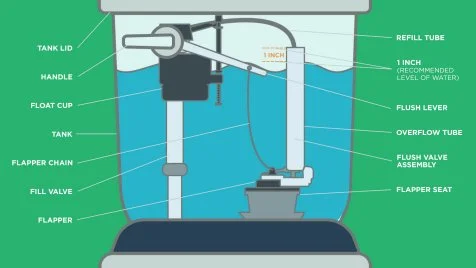A slow-filling toilet tank can be frustrating and wasteful. While a toilet tank typically fills in about three minutes, various issues can extend this time significantly[1]. This comprehensive guide will help you diagnose and fix your slow-filling toilet tank using simple DIY methods.
Common Causes of Slow Filling
Before attempting any repairs, it’s important to understand what might be causing your toilet tank to fill slowly. Here are the primary causes:
Water Supply Issues
- Partially closed shut-off valve
- Low water pressure
- Clogged water supply line[3]
Internal Component Problems
- Malfunctioning fill valve
- Waterlogged float ball
- Sediment buildup
- Damaged overflow tube[3]
Initial Diagnosis
Before making any repairs, perform these quick checks:
- Check Fill Time: Time how long it takes for your tank to fill after flushing. A normal fill time is about 3 minutes[1].
- Inspect Water Shut-off Valve: Look for the valve located behind your toilet near the wall. Ensure it’s fully open by turning it counterclockwise[1].
- Listen for Unusual Sounds: Unusual noises during filling can indicate internal problems with the fill valve or other components.
Step-by-Step Repair Procedures
1. Adjusting the Water Shut-off Valve
The simplest solution often starts with the shut-off valve. Here’s how to check and adjust it:
- Locate the valve behind your toilet
- Turn it counterclockwise completely
- Flush the toilet and observe fill time
- If fill time improves, this was your issue
2. Cleaning the Fill Valve
A dirty fill valve is often the culprit behind slow filling. Follow these steps to clean it:
Required Tools
- Adjustable pliers
- Bucket or towels
- Vinegar
- Soft brush
- Cup or container
Cleaning Process
- Turn off the water supply
- Remove the cap from the fill valve by twisting counterclockwise
- Place a cup over the exposed valve and turn water on briefly to flush debris
- Clean the valve opening with vinegar and a soft brush
- Reassemble the components
3. Checking and Replacing the Fill Valve
If cleaning doesn’t help, you may need to replace the fill valve entirely. Here’s a comparison of common fill valve types:
| Type | Pros | Cons | Average Cost |
|---|---|---|---|
| Float Cup | Reliable, adjustable | More parts to maintain | $10-15 |
| Float Ball | Simple design | Can waterlog over time | $8-12 |
| Modern Float-free | Precise, compact | More expensive | $15-25 |
Advanced Troubleshooting and Maintenance
4. Addressing Water Pressure Issues
Low water pressure can significantly impact tank filling speed. Here’s how to identify and address pressure issues:
Testing Water Pressure
- Check other faucets in your bathroom
- Use a water pressure gauge on the supply line
- Normal pressure should read between 40-60 PSI
- If pressure is low throughout the house, contact your water supplier
5. Dealing with Mineral Buildup
Hard water deposits can restrict water flow. Follow these steps to remove mineral buildup:
Cleaning Process
- Turn off water supply
- Disconnect supply line from tank
- Soak supply line in vinegar for 2-4 hours
- Scrub inside with bottle brush
- Flush line with clean water
- Reconnect and test
Preventive Maintenance Tips
To prevent future slow-filling issues, implement these maintenance practices:
Regular Maintenance Schedule
- Monthly: Check fill time and listen for unusual noises
- Quarterly: Clean fill valve and inspect components
- Annually: Deep clean and descale supply lines
- Bi-annually: Replace worn components
When to Call a Professional
While many toilet issues can be fixed DIY, certain situations require professional help:
- Persistent low water pressure
- Complex plumbing system issues
- Multiple toilet problems
- Damaged internal tank components
- Water damage around toilet base
Frequently Asked Questions
Q: How long should a toilet tank take to fill?
A normal toilet tank should fill within 2-3 minutes after flushing. If it takes longer than 5 minutes, there’s likely an issue that needs attention.
Q: Can hard water cause slow filling?
Yes, mineral deposits from hard water can accumulate in supply lines and valve openings, restricting water flow and causing slow filling.
Q: Is a slow-filling toilet wasting water?
While a slow-filling toilet doesn’t directly waste water, it often indicates inefficiency that could lead to incomplete flushes and multiple flushes, which do waste water.
Q: How often should I replace toilet components?
Most internal toilet components should be replaced every 4-5 years, even if they haven’t failed, to prevent issues and maintain optimal performance.
Troubleshooting Quick Reference Guide
| Symptom | Possible Cause | Solution |
|---|---|---|
| Very slow fill | Closed shut-off valve | Open valve fully |
| Inconsistent fill | Damaged fill valve | Replace valve |
| Noisy filling | Air in lines | Flush air from lines |
| Weak water flow | Mineral buildup | Clean supply line |
Essential Tools for Toilet Repair
Basic Tools
- Adjustable wrench
- Pliers
- Screwdriver set
- Plunger
- Bucket
Specialty Items
- Toilet fill valve
- Supply line
- Plumber’s tape
- Cleaning vinegar
- Water pressure gauge
Citations:
[1] https://www.lowes.com/n/how-to/fix-slow-filling-toilet
[2] https://www.youtube.com/watch?v=MwKZ7Z2SOl0
[3] https://nicholson-hvac.com/expert-tips/toilet-tank-not-filling-up/
[4] https://bestplumbers.com.au/plumbing-guides/slow-filling-toilet-tank/
[5] https://www.highervisibility.com/seo/learn/meta-tags/
[6] https://revenuezen.com/seo-titles-meta-descriptions/
[7] https://www.johncflood.com/our-blog/how-to-fix-a-slow-filling-toilet-after-flushing/
[8] https://www.teamlewis.com/magazine/seo-metadata-best-practices-on-page-optimization/
